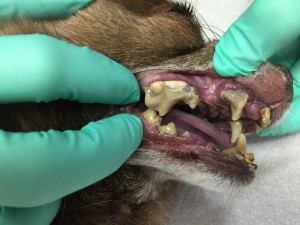Dental Care
Dental disease can severely impact the health of your pets. Bad breath, broken teeth, drooling, weight loss, discharge from the nose, and reluctance to eat or play, are all signs of dental disease. If your pet is exhibiting one or more of these signs, ask us today about scheduling your free dental exam.Proper dental care is LIFE CHANGING for dogs and cats. This is our specialty and our passion. Dr. Bialon and our dental technician, Lisa, received advanced training in veterinary dentistry.
We have a fully equipped, state of the art dental suite dedicated to your pet’s oral health. Every dog or cat needs a dental exam every year. It’s important to have their teeth examined as soon as you bring them home. Many dental issues are preventable. We walk through the process with you.
Bloodwork to make sure your pet is a candidate for anesthesia
Intubate with a tracheal tube
IV catheter with fluids
Full mouth dental x-rays
Dental cleaning and polish
Oral exam with detailed charting of pathology
Discussion options with the client
Cleaning
Our Dentalaire Prestige Dental unit includes ultrasonic scaler, polisher, high speed hand piece.
Did you know that 85% of pets have periodontal disease by the age of three? Your pet’s mouth should be disinfected regularly through daily brushing. Just like in our mouths, plaque and tarter accumulate rapidly. Regardless of whether or not your brush your pet’s teeth, Dogs and cats require periodic professional cleaning. We recommend yearly dental exams and cleanings.
When buying dental treats for your pet, look for the “VOHC” stamp of approval. The VOHC is the veterinary oral health council. Regular use of products containing the VOHC seal will reduce the severity of periodontal disease in pets. You can view a list of products approved by the Veterinary Oral Health Council on line. Cow hooves and bones are not appropriate chew toys as they are too hard and can readily break teeth.
Procedures
Open and closed root planing
Extractions
Bonded sealants
Digital dental x-rays
An oral health evaluation is not complete without full mouth x-rays. The amount of pathology and disease present below the surface of the gingiva will astound you.
Multi-modal pain control:
We tailor our protocols to each individual pet’s needs. We use local numbing agents for all pets undergoing dental surgical procedures. We use additional pain medications and anti-inflammatories as needed. We incorporate cold laser in the post-operative period to facilitate healing at the incision site.
Jag’s Story
“Jags” is a working ranch dog that came in for a hurt leg when we saw his teeth that had been kicked by a cow. Both canine teeth were fractured exposing the pulp chamber where the nerve and artery are housed. This inner chamber was packed with debris and infection. Jags’ infected teeth were removed and he acted like a whole new dog. The canine teeth are important teeth that we would like to preserve, but in Jags’ case, they were a constant source of pain and infection.
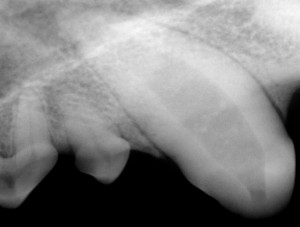
X-ray of canine tooth.
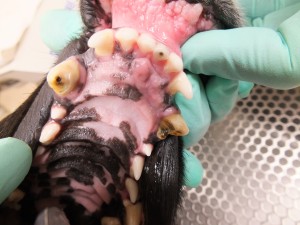
Photo showing pulp chamber exposure in both canine teeth and the incisor.
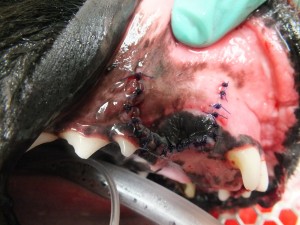
Photo of surgery site following extraction of canine tooth.
Dina’s Story
Dina, a one year old shitzhu mix that had a severe underbite. The owner thought that she just had an attitude problem and was naturally crabby.
The truth is that Dina could not close her mouth without experiencing pain when her upper teeth dug into her lower jaw and tongue. Once these teeth were extracted and Dina could close her mouth without pain, Dina’s mom could see an immediate change in Dina’s entire demeanor.
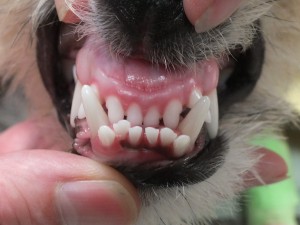
Severe underbite.
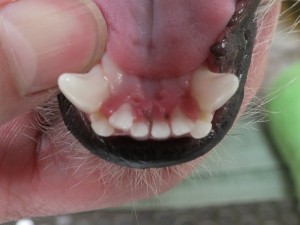
Note indentations where incisors were traumatizing the soft tissues.
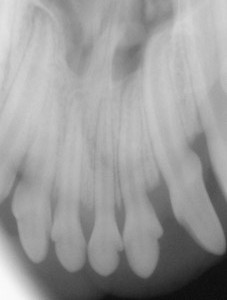
X-ray of top incisors before extraction.
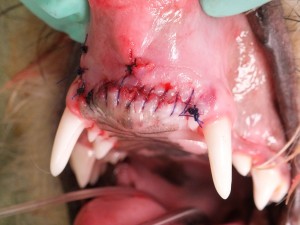
Closure of surgery site after extraction of top incisors.



